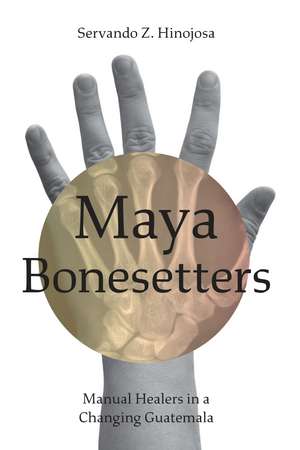Maya Bonesetters: Manual Healers in a Changing Guatemala
Autor Servando Z. Hinojosa Ilustrat de Servando G. Hinojosaen Limba Engleză Hardback – 28 feb 2020
Drawing on extensive field research in highland Guatemala, Servando Z. Hinojosa introduces readers to a seldom documented, though nonetheless widespread, variety of healer. This book examines the work of Kaqchikel and Tz’utujiil Maya bonesetters, analyzes how they diagnose and treat injuries, and contrasts the empirical and sacred approaches of various healers. Hinojosa shows how bonesetters are carefully adapting certain biomedical technologies to meet local expectations for care and concludes that, despite pressures and criticisms from the biomedical community, bonesetting remains culturally meaningful and vital to Maya people, even if its future remains uncertain.
Preț: 532.15 lei
Preț vechi: 691.11 lei
-23% Nou
Puncte Express: 798
Preț estimativ în valută:
101.83€ • 106.58$ • 84.75£
101.83€ • 106.58$ • 84.75£
Carte tipărită la comandă
Livrare economică 31 martie-14 aprilie
Preluare comenzi: 021 569.72.76
Specificații
ISBN-13: 9781477320280
ISBN-10: 1477320288
Pagini: 256
Dimensiuni: 152 x 229 x 15 mm
Greutate: 0.51 kg
Editura: University of Texas Press
Colecția University of Texas Press
ISBN-10: 1477320288
Pagini: 256
Dimensiuni: 152 x 229 x 15 mm
Greutate: 0.51 kg
Editura: University of Texas Press
Colecția University of Texas Press
Notă biografică
Servando Z. Hinojosa is a professor of anthropology at the University of Texas Rio Grande Valley. He is the author of In This Body: Kaqchikel Maya and the Grounding of Spirit and coeditor of Healing by Hand: Manual Medicine and Bonesetting in Global Perspective. Servando G. Hinojosa is a retired educator and an active sculptor, muralist, and illustrator.
Cuprins
Preface and Acknowledgments
Introduction
Chapter 1. Bonesetting over Time
Chapter 2. Empirical Forms of Maya Bonesetting
Chapter 3. Sacred Forms of Maya Bonesetting
Chapter 4. Challenges and Changes in the Injury Landscape
Conclusion
Appendix. Traditional Medicine and Bonesetting: Integration and Lessons
Notes
References
Index
Introduction
Chapter 1. Bonesetting over Time
Chapter 2. Empirical Forms of Maya Bonesetting
Chapter 3. Sacred Forms of Maya Bonesetting
Chapter 4. Challenges and Changes in the Injury Landscape
Conclusion
Appendix. Traditional Medicine and Bonesetting: Integration and Lessons
Notes
References
Index
Recenzii
[A] well-written, well-researched ethnograpy of bonesetting among Guatemalan Maya…Recommended.
[Maya Bonesetters] adds rich detail to our understanding of the accommodations that Indigenous healers often make to the challenge of biomedicine, how they will accept and integrate into their practice new ideas, new terminology, new medicines, and even new technology...This is a strong work presenting ideas about the contemporary context of Indigenous medicine that approaches the topic from the angle of empiricism and pragmatism. As a contribution to the anthropology of healing it is invaluable. Scholars of the Maya will find great value here as Hinojosa takes the reader into the villages and therapeutic spaces of pain and suffering that are relatively undocumented.
Maya Bonesetters should appeal to anthropologists and those in the disciplines of natural medicine, indigenous healers like curanderas, and individuals with traditional healing in their ancestral memories...This is a fascinating book for use by anthropologists focused on the Americas, and is a resource for those in other disciplines, sociology, psychology, with an interest in natural healing and its connection to social and mental health...Without a doubt, this is a highly absorbing book.
The most important contribution of this book is its focus on a healing tradition that has not received the academic attention it deserves...In his convincing discussion of the injustice of this omission, Hinojosa restores the bonesetters to a valued position in Mesoamerican ethnology and medical anthropology in general...this study represents an advance in recognition of indigenous healing knowledge and techniques. As indigenous knowledge is increasingly valued, the bonesetters and their skills in diagnosing injuries, massaging muscles and restoring movement will be more widely accepted, not only in Guatemala but around the world. This book is more than a first approximation to this healing tradition and the changes it is facing in its coexistence with biomedicine; it is also a tribute to this important area of humanity’s knowledge.
[Maya Bonesetters] is an important document of an often overlooked Indigenous healing practice that will be of interest to scholars and students of medical anthropology, Mesoamerica, and anyone with an interest in contemporary health care challenges in Latin America.
Descriere
The first book to thoroughly examine bonesetting in Guatemala, Maya Bonesetters offers an ethnographic portrait of an underdocumented yet culturally vital healing tradition within the lived landscape of its practitioners.
